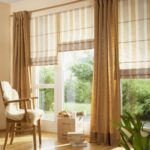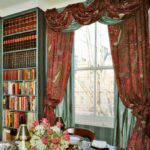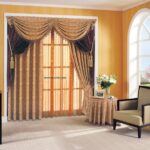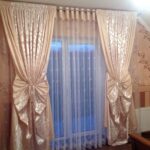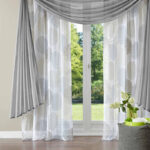Varieties and phasing of drapery curtains
Drapery of curtains plays an important role in window decoration, and a beautiful window opening is the key to a stylish interior. Voluminous or crossed curtains will brighten up any design. What are the ways of draping? A few practical tips from professional designers.

Drapery rules
- It is best to drape plain fabrics. A striking pattern and noticeable relief are in themselves an interior decoration. If you drape fabrics with a print, it will look too clumsy and, often, inappropriate. A harmonious interior can be easily spoiled by drapery of colored curtains or curtains.
- Use soft fabrics to create soft, neat folds. Batiste, velor, velvet and silk are the most suitable materials. Draping dense fabrics such as brocade creates pronounced folds and an overly decorative look. Although, in fairness, it is worth noting that for some interiors this type of drapery will be suitable.
- For drapery at home, use a special curtain tape. Each fold is already embedded in it and you do not have to calculate every centimeter of fabric yourself. In work, such a tape is extremely simple: the braid is sewn to the edge of the canvas, and then one thread is pulled out, forming the folds necessary in volume.

Please note that drapery tape is different:
- Plain tape. Helps to create an "accordion" on the fabric;
- French braid. This option is more difficult and will require certain skills and accuracy. It is important to make an accurate calculation of the width of each fold, then lay a line along the entire length of the canvas through equal segments. Then the resulting folds are fanned and stitched again.
- Ribbon corrugation. Thanks to it, soft volumetric folds are obtained.

However, you can drape curtains with your own hands not only with the help of curtain tape, there are several more simple decorative elements that will make spectacular folds on the curtain or curtain:
- Strings;
- Rings;
- Hinges;
- Magnets;
- Decorative clips;
- Cords and tapes;
- Hangers for curtains;
- Curtain brooches.
All of the above elements allow you to create one-of-a-kind curtains that complement your interior and create a mood for you.
Additional drapery elements
To make it even more decorative, you can use additional elements, such as lambrequins, swag, semi-swag, jabots, ties and puffs.

Lambrequin
A pelmet is an elongated strip of fabric attached to the cornice and the top of the curtain.
It is important to choose the right material for the lambrequin. It should be combined with the general style of the room, as well as with the main curtain fabric. It is not recommended to use dense and textured fabrics, since they are not very good at draping: they are rough and do not allow you to create any shapes.And soft flowing fabrics such as silk, organza, chiffon, voile or satin will perfectly complement any curtains. In addition, the material is pleasant to the touch.

Important: natural fabrics are prone to fading, so it is better to choose materials with synthetic additives.
The color of the lambrequin should be combined with the color scheme of the interior: not to get lost against the general background, but also not to "scream" about its existence.
Designers recommend choosing a shade for the lambrequin and other decorative elements that is slightly darker than the main curtains and other textile interior elements.
If there is an ornament on the curtains, then it should correspond to the ornament of the wallpaper or the color of the walls, as well as complement the pattern on the carpet.
Swag
This element is considered part of the lambrequin. It is a semicircle, which is also assembled from neat folds in the shape of a semicircle. When cutting a swag, it should be 45 degrees in order to get an effective and correct addition to the curtains.

Depending on the size, the number of these elements also changes. For example, on a large curtain design, there may be two or three of them. If a small distance remains between them, then, as a rule, it is filled with a different decor: ties or chill molds.

Half-wag and crossover
A semi-wag, as the name suggests, is only slightly different from a swag - free space is left at the top of the structure. Semi-wag can be symmetrical or asymmetrical. In the first case, the structure is distributed evenly over the entire length of the cornice, and in the second, the free part of the semicircle is shifted to the right or left.

The throws are the simplest element: a light canvas is simply thrown one or more times over the cornice.

Jabot and tie
A jabot is a one-way cascade that can be stepped or beveled. This design is usually placed on the sides of the curtain trim. Such decor attracts attention and visually expands the window opening. Sometimes it is placed in the center of the curtain ensemble between the swagas.

A tie differs from a jabot only in width. It is located on the sides of the curtain, in such a way that its long side is located close to the curtains, and the short one is slightly outside.

Puffs
This decor is located at the top of the curtains and looks like a piece of fabric with many different folds. Due to the folds, various geometric shapes are formed: rhombuses, zigzags. Also, puffs can be in the form of flowers or braids. Very often, plain fabric puffs are complemented by a light curtain fabric with an unobtrusive pattern. In order to get an elegant piece of jewelry, you have to work hard. It is important to follow the existing scheme exactly, as even one incorrectly laid line will ruin the whole picture.
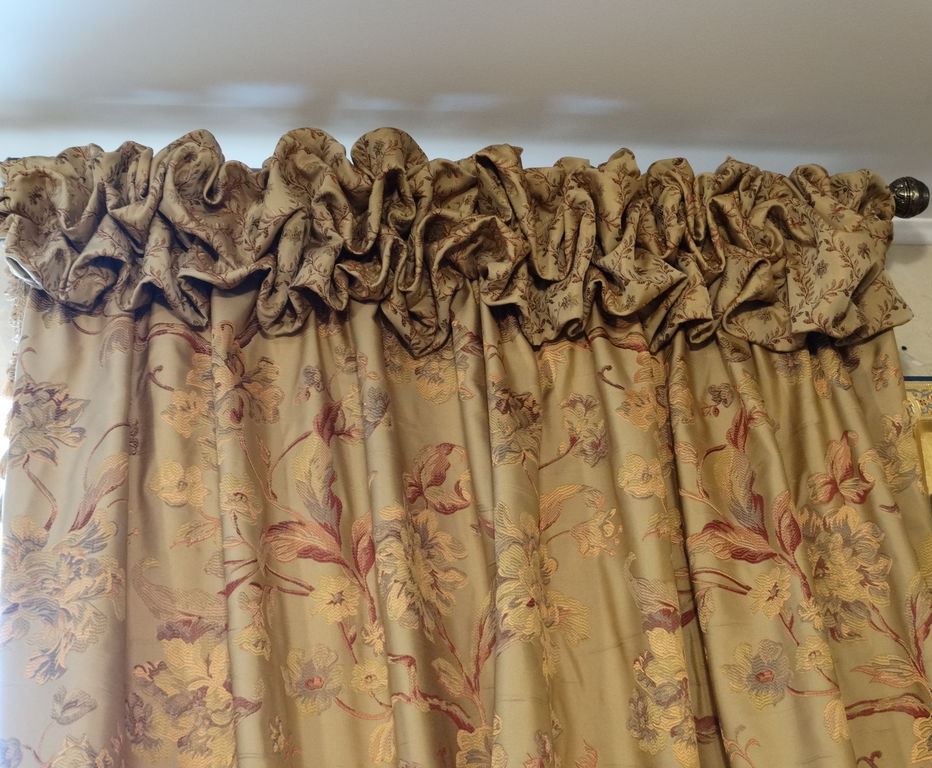
This type of drapery is made both by hand and on a typewriter. The main requirement for the material: it should easily form folds of different directions.
Curtains decorated with puffs fill the room with elegant luxury, it is no coincidence that they are often used to decorate classic interiors.
Drapery in any form and manifestation is a spectacular decor of a curtain structure. If you make it yourself, then you are guaranteed a unique and stylish design. Today, a huge selection of all kinds of decorative elements and techniques for finishing curtains is offered, you are guaranteed to find your own way to make the window opening functional and interesting.

Video: how to beautifully drape curtains and tulle























